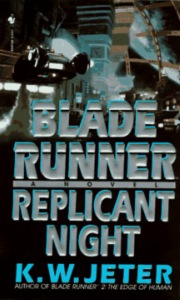With only a year between novels, it’s unlikely K.W. Jeter was reacting to readers’ complaints about “Blade Runner 2: The Edge of Human” when crafting “Blade Runner 3: Replicant Night” (1996). But it plays like he was. His second sequel to the 1982 Ridley Scott classic breaks free of rain-drenched bounty hunting and delves into Philip K. Dick’s most beloved themes.
(Some readers complained that “Edge of Human” wasn’t Dickian enough. Some were disappointed that it’s not a sequel to “Do Androids Dream of Electric Sheep?” – although I don’t know what more Bantam could’ve done to make it clear it’s a “Blade Runner” sequel.)
PKD tropes
In “Replicant Night” – set shortly after the 2020-set part two — Jeter again writes in his own wordy, hardboiled style, wisely not trying to mimic Dick’s prose. But he taps into several PKD tropes this time, notably the marital problems that dominate the thoughts of Rick Deckard and Sarah Tyrell even amid their extreme adventures.
There’s also a talking briefcase containing the mind of Roy Batty, and a Martian colony ruled by a cable monopoly. And the author regularly uses one of PKD’s favorite words: “autonomic.” The couple’s autonomic alarm clock and calendar would be at home in “The Game-Players of Titan.”
I admired Jeter’s restrained portrayal of the tragic Deckard-Sarah relationship in “Edge,” but I would’ve liked him to go deeper into their troubles here.
The marriage is built on the idea that maybe Deckard can find happiness if he pretends Sarah is Rachael (who expires from her four-year lifespan in part two) and maybe the unloved Sarah can pretend Deckard’s faux love is the real thing.
PKD would’ve likely shown the whole rollercoaster (I’m thinking of something like “Now Wait for Last Year”); Jeter shows only the bottomed-out phase. Deckard is even more resigned and morose than before, while Sarah is murderous. It’s been said there’s a thin line between love and hate, but not for her.
More ambitious
Other than that misstep, “Replicant Night” is excellent, and more ambitious than “Edge,” even though the story doesn’t zoom forward. It draws from the movie like the previous book, but in a weirder way: We see artificially replicated places, events and time periods.
Jeter goes meta before it was cool with the invention of Outer Hollywood, an Earth-orbiting satellite. Commenting on modern effects-heavy filmmaking, specifically the illusions of the groundbreaking “Blade Runner,” Jeter invents a filmmaker who aims to capture Deckard’s murder on camera for the sake of making a hit movie.
Perhaps the most PKD-ish touch is the cable monopoly that rules the miserable Martian colony, which exists under a dome a la “Total Recall” (1990). People who have taken up the U.N.’s offer to travel to the stars are stuck at a bottleneck on Mars, which doesn’t have the Bleekmen of “Martian Time-Slip,” but definitely has bleak men.

The miners are born on Mars (which allows them to do their jobs better), and they are content even though their lives seem miserable to outside observers. The Earth-born colonists desire stimulus, which is how the cable company – granted a monopoly by the U.N. — has them under its thumb. It’s a more amusing answer to the way “Total Recall’s” colonists are dominated by the air utility.
The coolest SF aspect of “Replicant Night” is the time bubble that naturally exists in Scapa Flow, a part of the Atlantic Ocean protected by a circle of islands north of Scotland. This section of the book reads like a Preston & Child novel in the way it combines real geography, real history and barely plausible science.
Back to the Salander 3
The Salander 3 (the spaceship on which Sarah was born, introduced to this continuity in “Edge” and drawn from “Do Androids Dream of Electric Sheep?”) has been scuttled at the bottom of Scapa Flow because time stands still here, so it’s the safest place to dispose of the engine.
On the airtight ship, Sarah finds a 10-year-old girl named Rachael who looks to be her time-delayed twin. Sarah’s insistence that Rachael is a hallucination, even though everyone can see her, is a frustrating aspect of her character; she’s nuts, but in a too-simple fashion.
I expect Jeter’s further blurring of the line between humans and replicants in “Replicant Night” is controversial, with some readers loving it and some hating it. Logically, since replicants are run off assembly lines by the Tyrell Corporation, there should be a clear way to identify them, like the hosts in “Westworld.”
That notion nags at the back of my mind when reading these “BR” books, and also in PKD works dating back to the short story “Impostor,” where a man is accused of being an android and has no way to prove he isn’t. “Androids” and “Blade Runner” make it clear that the Voigt-Kampff empathy test and the four-year lifespan (revealed only when it reaches its end) are the only ways to tell replicants from humans, and I need to accept that conceit at this point.
By the time of “Replicant Night,” the conundrum has reached its extreme end. In a Crichtonian twist, replicants can reproduce – and humans can’t — once they are outside of the Earth’s magnetic field. Here, Jeter adds some religio-mysticism via the idea of God’s Eye of Compassion, which generally speaking means God grants and takes away humanness based on moral decency.
War is brewing
The U.N. doesn’t like the idea that replicants are replacing humans as the dominant species on these colonies that represent the bright future of the human race. So war is brewing between humans who resemble replicants and replicants who resemble humans. Now that’s something PKD would appreciate.
“Replicant Night” gains intrigue with its promise that Deckard will travel to the colonies, but ultimately he spends this story on Mars and Outer Hollywood and in a pocket universe of Sebastian’s. (When Deckard is able to bring an object from that mindscape back into reality, it’s a very Dickian “just go with it” element of weirdness.)
This calls to mind Dick’s early novels, wherein the frontier is an ephemeral place of hope and mystery but characters don’t necessarily reach it.
When they do start to reach the frontier in his later novels, it’s often far short of a utopia, and we’ve already been told that’s the case in the “BR” universe – dating back to Batty’s description of space warfare in the movie — even though Deckard hasn’t gone there.
Presumably he does in the final entry, “Blade Runner 4: Eye and Talon” (2000), which is the Holy Grail for “BR” spinoff fiction collectors, usually priced at $100 or more because of its rarity.
I recommend these first two Jeter books for people who love the world of “Blade Runner.” The connections to PKD are more academic than they are deeply felt in the prose, but “Replicant Night” hits on many more PKD themes than “Edge of Human” does, so it might win back some of Jeter’s critics.


